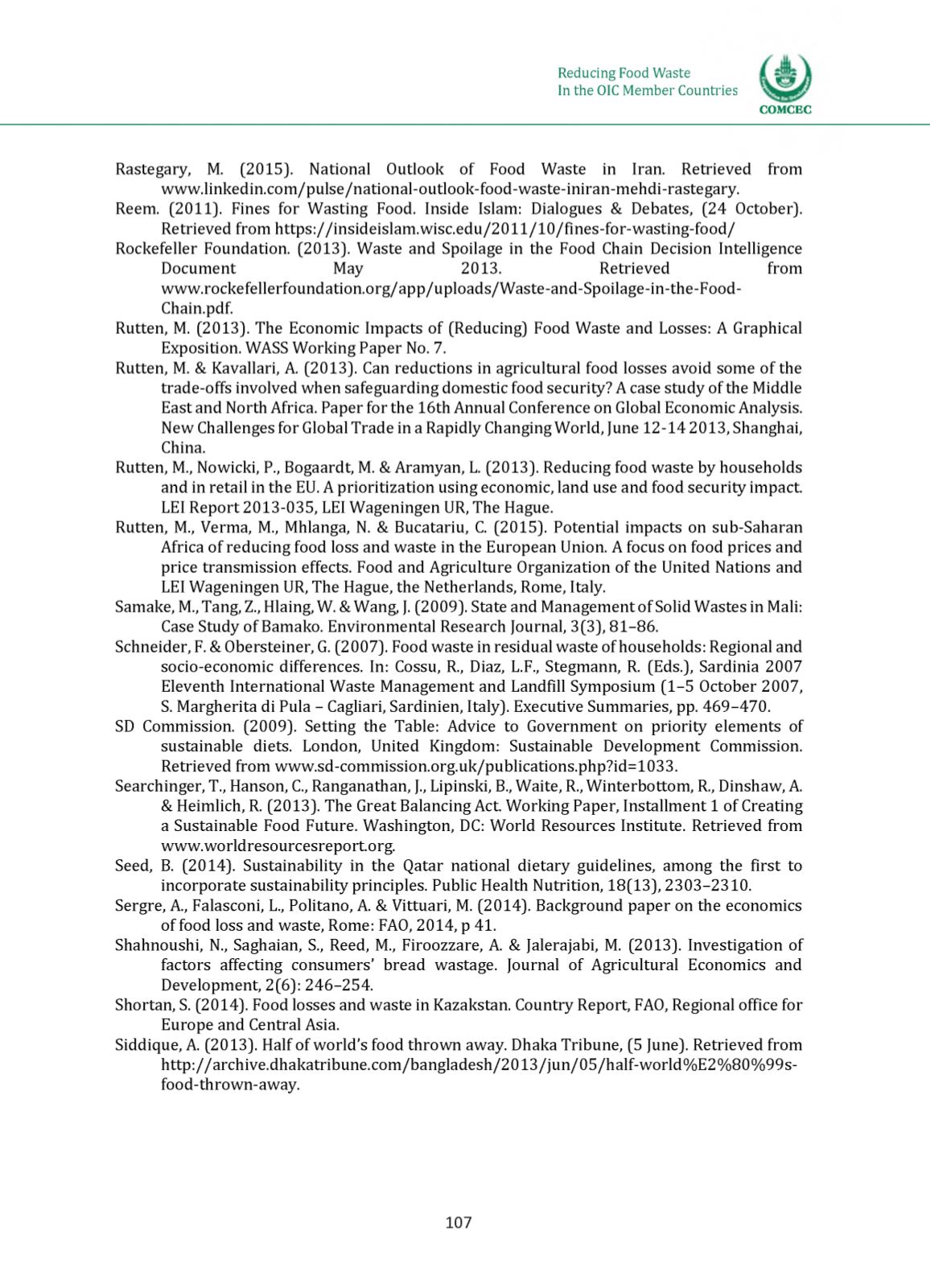

COMCEC
Reducing Food Waste
In the OIC Member Countries
Rastegary, M. (2015], National Outlook of Food Waste in Iran. Retrieved from
www.linkedin.com/pulse/national-outlook-food-waste-iniran-mehdi-rastegary.Reem. (2011). Fines for Wasting Food. Inside Islam: Dialogues & Debates, (24 October].
Retrieved from
https://insideislam.wisc.edu/2011/10/fines-for-wasting-food/Rockefeller Foundation. (2013). Waste and Spoilage in the Food Chain Decision Intelligence
Document
May
2013.
Retrieved
from
www.rockefellerfoundation.org/app/uploads/Waste-and-Spoilage-in-the-Food-Chain.pdf.
Rutten, M. (2013). The Economic Impacts of (Reducing] Food Waste and Losses: A Graphical
Exposition. WASS Working Paper No. 7.
Rutten, M. & Kavallari, A. (2013). Can reductions in agricultural food losses avoid some of the
trade-offs involved when safeguarding domestic food security? A case study of the Middle
East and North Africa. Paper for the 16th Annual Conference on Global Economic Analysis.
New Challenges for Global Trade in a Rapidly ChangingWorld, June 12-14 2013, Shanghai,
China.
Rutten, M., Nowicki, P., Bogaardt, M. & Aramyan, L. (2013). Reducing food waste by households
and in retail in the EU. A prioritization using economic, land use and food security impact.
LEI Report 2013-035, LEI Wageningen UR, The Hague.
Rutten, M., Verma, M., Mhlanga, N. & Bucatariu, C. (2015). Potential impacts on sub-Saharan
Africa of reducing food loss and waste in the European Union. A focus on food prices and
price transmission effects. Food and Agriculture Organization of the United Nations and
LEI Wageningen UR, The Hague, the Netherlands, Rome, Italy.
Samake, M., Tang, Z., Hlaing, W. &Wang, J. (2009). State and Management of Solid Wastes in Mali:
Case Study of Bamako. Environmental Research Journal, 3(3), 81-86.
Schneider, F. & Obersteiner, G. (2007). Food waste in residual waste of households: Regional and
socio-economic differences. In: Cossu, R., Diaz, L.F., Stegmann, R. (Eds.), Sardinia 2007
Eleventh International Waste Management and Landfill Symposium (1-5 October 2007,
S. Margherita di Pula - Cagliari, Sardinien, Italy). Executive Summaries, pp. 469-470.
SD Commission. (2009). Setting the Table: Advice to Government on priority elements of
sustainable diets. London, United Kingdom: Sustainable Development Commission.
Retrieved from
www.sd-commission.org.uk/publications.php?id=1033.
Searchinger, T., Hanson, C., Ranganathan, J., Lipinski, B., Waite, R., Winterbottom, R., Dinshaw, A.
& Heimlich, R. (2013). The Great Balancing Act. Working Paper, Installment 1 of Creating
a Sustainable Food Future. Washington, DC: World Resources Institute. Retrieved from
www.worldresourcesreport.org.Seed, B. (2014). Sustainability in the Qatar national dietary guidelines, among the first to
incorporate sustainability principles. Public Health Nutrition, 18(13), 2303-2310.
Sergre, A., Falasconi, L., Politano, A. & Vittuari, M. (2014). Background paper on the economics
of food loss and waste, Rome: FAO, 2014, p 41.
Shahnoushi, N., Saghaian, S., Reed, M., Firoozzare, A. & Jalerajabi, M. (2013). Investigation of
factors affecting consumers’ bread wastage. Journal of Agricultural Economics and
Development, 2(6): 246-254.
Shortan, S. (2014). Food losses and waste in Kazakstan. Country Report, FAO, Regional office for
Europe and Central Asia.
Siddique, A. (2013]. Half of world’s food thrown away. Dhaka Tribune, (5 June). Retrieved from
http://archive.dhakatribune.com/bangladesh/2013/jun/05/half-world%E2%80%99s-food-thrown-away.
107
















